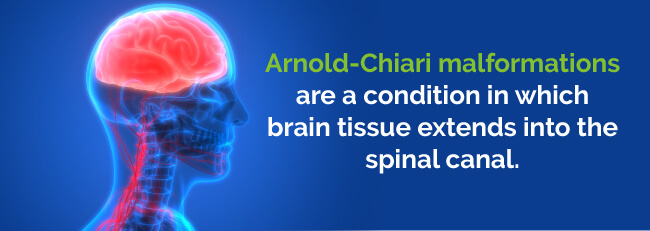It’s natural to want more information if you have a diagnosis of Arnold-Chiari Malformation, as you may not have heard about it before. The condition can be debilitating and painful. Due to its side effects, you may feel conventional medications are doing you more harm than good. If this is the case, taking medical marijuana could help.
Here, we look at what Arnold-Chiari malformation is, its symptoms and effects, as well as its current treatments and their side effects. We also find out how medical marijuana for Arnold-Chiari malformation can help ease your symptoms and give you a better quality of life.
Cannabis use is finally beginning to lose the stigma it once had since the legalization of medical marijuana. It’s no longer associated with dropouts and hippies, and there’s a growing body of research that proves it has positive medicinal effects. So, how can marijuana for Arnold-Chiari malformation help you?
Find A Doctor Find A Dispensary
Cannabis use is widespread in patients with painful chronic illnesses. In fact, in this group of people, the most frequently reported reasons for taking pot is to improve mood, pain and sleep. It’s the cannabinoids, cannabidiol (CBD) and tetrahydrocannabinol (THC) that have a positive effect on pain reduction.
The relaxation provided by taking pot also helps you if you’re anxious or suffering from depression. It can also assist you in other physical ways.
There are many ways pot can help you relieve the symptoms of CM. Cannabis can treat:
Read on for more help and information on marijuana and Arnold-Chiari malformation.
Using cannabis for Arnold-Chiari malformation is a useful and natural complement to surgical treatments. With this in mind, let’s look at some of the best strains to use for each symptom.
It can be annoying when you can’t sleep for a night or two. If you have CM, your insomnia can be chronic. You may lay in bed all night wishing for sleep only to get an hour or two if you’re lucky. Lack of sleep can make you exhausted, cranky and confused. If you don’t want to spend months or even years on sleeping medications, cannabis can help. Some of the best strains for helping you sleep include:
Weeks, months and years of chronic pain can bring you down. You may find you no longer have interest in activities you used to love. Perhaps you’re withdrawing from family and friends. You’ve no idea when you can see your loved ones as you have to cancel arrangements regularly due to your pain. In time, people may stop inviting you places, making you feel even more cut off from society.
If you’ve been experiencing chronic pain, these pot strains can help:

When you’re suffering from CM, depression can make worsen your other symptoms. You may wish to try some of the below pot strains rather than taking anti-depressant medications:
Speak with your surgeon about your treatment options before you make your final decision as to how you approach your condition.
We hope you’ve enjoyed reading about cannabis and Arnold-Chiari malformation and the specific strains that help you cope with your CM symptoms. If you need any more help and advice, speak to a marijuana doctor or experienced budtender.
Making the right choice can be overwhelming when you’re a pot novice. Thankfully, there is more and more help out there. Why not find out more by searching for a medical marijuana dispensary or doctor today? It’s time to take back control of your condition. Here at MarijuanaDoctors.com, we can help you improve the quality of your life.
For more information about how cannabis can be used to treat Arnold-Chiari Malformation, check out our resources:
Find A Doctor Find A Dispensary
Arnold-Chiari malformations, also known as Chiari malformations, are structural defects within the cerebellum and base of the skull. The cerebellum is the area of the brain that controls your balance. Usually, portions of the brain stem and the cerebellum sit above an opening in your skull, and your spinal cord can pass through it.

It’s called a Chiari malformation (CM) when your cerebellum extends below this area and into the upper spinal canal. This condition causes pressure on your brainstem and cerebellum. In turn, this blocks the flow of cerebrospinal fluid (CSF) that acts as a cushion for your spinal cord and brain.
CSF also plays a role in removing waste products from your brain and circulating chemical and nutrients that have been filtered from your blood. The condition negatively impacts many of your physical functions. Chiari malformation is uncommon. However, imaging tests are leading to a more frequent diagnosis of the condition that often occurs when a part of your skull is misshapen or abnormally small. Speak to your doctor without delay if you feel you could be affected by the condition.
Hans Chiari was an Austrian pathologist who initially identified the three types of Chiari malformation in 1981. Julius Arnold went on to further expand the meaning of CM type ll. Some medical sources, therefore, call the condition Arnold-Chiari malformation, although there are a handful of interchangeable names for the condition that are in use. These include Tonsillar Ectopia, CM and Hindbrain Herniation.
Today, there are four identified types of Chiari malformations.
Type 0 might be part of this list, but it’s a controversial and newly identified type of Chiari malformations. Syrinix (a fluid-filled cavity in the spinal cord) is present, but doesn’t meet other criteria of the condition.
The treatment you receive for Arnold-Chiari malformation depends on the symptoms, form and severity. If you’d prefer to treat your non-surgically related symptoms in a natural way, perhaps medical pot can help.
Severe headaches are a classic symptom of the disorder. These often occur after you’ve strained, coughed or sneezed. You may also experience the following if you have CM type l:
Other less common symptoms include:
In type ll, a larger amount of tissue extends into your spinal canal than in CM type l. Additionally, the symptoms and signs may relate to a form of spina bifida known as myelomeningocele, which is a condition that almost always is seen alongside CM type ll. In myelomeningocele, your spinal canal and backbone hadn’t correctly closed before you were born. Symptoms include:
This is perhaps the most severe type of CM. It’s characterized by a part of the cerebellum — the lower back area of your brain — or your brain stem extending through an abnormal opening in the rear of your skull. This type of CM is either diagnosed via ultrasound during pregnancy or at birth. It may cause neurological problems and has a higher mortality rate.
In type IV, the cerebellum is either undeveloped or incomplete, which is referred to as cerebellar hypoplasia. In some patients, parts of the spinal cord and skull are exposed and visible. This is the most severe form of Chiari Malformation, and, if it occurs during infancy, it can be fatal.
There are many individuals with Chiari malformation who have no symptoms or signs of the condition, and therefore, don’t need treatment. The condition may only be flagged during tests for something that’s entirely unrelated. For others, Chiari malformation can cause various problems, depending on the severity and type you have.
These malformations show up as structural defects within the cerebellum, which is the part of the brain that controls balance. The pressure on the cerebellum can block the flow of cerebrospinal fluid, which usually protects and surrounds the brain and spinal cord. As a result, loss of balance, disorientation, vision problems, lack of coordination and frequent numbness can occur.
The most commonly recognized form of CM is Type I, which can be asymptomatic and is often uncovered incidentally during routine examinations for other conditions. Type II is often accompanied by a form of spina bifida, causing the spinal cord to protrude through an opening in the back. Type III is the most severe form of CM, which causes severe neurological defects.
Suffering from Arnold-Chiari malformation is just that, suffering. The pain and side effects of the condition are isolating and debilitating. It can be tough to gain respite. When you’re constantly in pain, you may feel disconnected even from those closest to you.
Your symptoms may be unpredictable and erratic. You may be unable to make plans for fear or feeling too unwell to function. You probably feel overwhelmed and lonely as you search for answers. Other feelings you might need to deal with include irritability, depression and short-temperedness. For this reason, it’s crucial to get the right treatment such as medical cannabis for Arnold-Chiari malformation that can help you.

As previously stated, some cases of CM do not present any symptoms, and therefore don’t interfere with your quality of life. Generally, doctors recommend regular MRI scans to monitor your condition if this is the case. If you’re experiencing headaches or pain, you’re prescribed painkilling medications to help ease your symptoms. Some painkillers can be addictive and may have adverse side effects if taken over a protracted period.
As far as treatment is concerned, decompressive surgery can be utilized for more extreme cases, removing the second and third cervical vertebrae. Additionally, the stopping of spinal fluids may be aided by an implanted shunt.
For patients seeking less invasive treatment plan, medical-grade marijuana is recommended for immediate pain relief specifically targeting chronic muscle pain, weakness, headaches and fatigue. Sativa-dominant strains work best to reduce nausea, reduce and relieve pain and increase muscle capability.
Surgery is the only treatment available to many people to halt the progression of central nervous system (CNS) damage and to ease their symptoms. For most people, surgery can stabilize or improve symptoms of CM. More than one surgery may be needed if you go down this route.